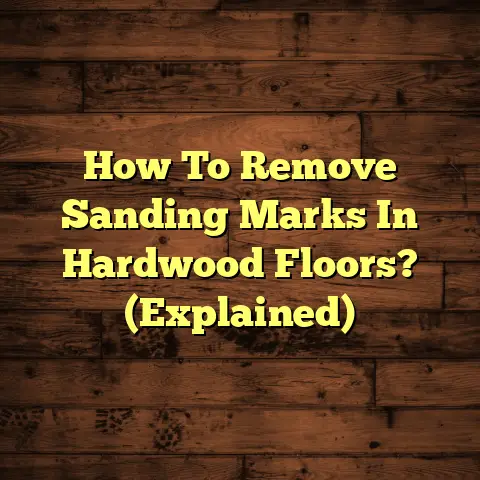Blue Ridge Hardwood: Worth It? (5 Top Complaints!)
Hardwood flooring is a classic choice.
It brings warmth, elegance, and
durability to any home.
I’ve installed countless hardwood floors
over the years.
I’ve seen the joy it brings.
Blue Ridge Hardwood is a popular brand, known for its wide selection
and reasonable price point.
But is it the right choice for you?
While many homeowners love their Blue Ridge floors, I’ve also heard
some common complaints.
Let’s dive into the top 5 issues you should
consider before making a purchase.
Section 1: Noise Reduction and
Acoustic Properties
Let’s talk about noise!
It’s a big factor for
many homeowners, especially in apartments or homes
with kids.
How does hardwood, including Blue Ridge, stack up?
Hardwood, in general, isn’t the best for sound absorption.
It’s a hard surface, so sound waves tend to bounce off it.
Think about the difference between walking into a room
with carpet versus one with hardwood – you can hear the echo.
Compared to carpet, hardwood is louder.
Carpet absorbs sound.
Laminate can be similar to hardwood.
Tile is often the loudest.
However, there are ways to mitigate noise with hardwood.
Installation Method Matters:
-
Nail-down: This traditional method can sometimes transmit more sound, especially if not installed properly.
-
Glue-down: This can help dampen sound a bit better than nail-down.
-
Floating: Often used with engineered hardwood, this method can benefit from an underlayment.
Underlayment is Key:
Speaking of underlayment, it’s your secret weapon for sound reduction!
Acoustic underlayment pads can significantly reduce sound
transmission.
These are installed between the subfloor and the
hardwood.
They come in various thicknesses and materials, so
you can choose one that fits your needs.
Homeowner Experiences:
I’ve heard from homeowners who love the look of their Blue
Ridge floors.
Some have added area rugs to soften the sound.
Others have used thicker underlayment.
One homeowner told me, “We installed Blue Ridge in our
upstairs hallway, and we could hear every footstep downstairs.
Adding a soundproof underlayment made a huge difference!”
My Recommendation:
If noise reduction is a major concern, don’t rely solely on
Blue Ridge Hardwood itself.
Invest in a quality acoustic
underlayment.
Consider area rugs to further dampen sound.
Section 2: Top Complaint #1 –
Scratching and Dents
Okay, let’s get to the first big complaint: scratching and dents.
This is a common concern with any hardwood floor.
But it’s especially relevant when considering different
brands and wood species.
Hardness Matters (Janka Rating):
The Janka hardness scale measures the resistance of a wood
species to denting and wear.
The higher the number, the
harder the wood.
Blue Ridge offers various wood species.
Some are harder than others.
Red Oak: Typically around 1290 on the Janka scale.
It’s a decent choice for durability.Hickory: Can range from 1820 to over 2000.
This is a much harder, more durable option.-
Maple: Usually around 1450. It’s harder than Red Oak.
Brazilian Cherry (Ipe): Can be over 3500.
It’s an extremely hard and durable exotic wood.
User Experiences:
I’ve seen floors that look beautiful for decades.
I’ve seen others that show wear and tear quickly.
A client of mine with two large dogs installed Blue Ridge
Red Oak.
She was disappointed by how easily it scratched.
“Within a few months, I could see scratches from their nails,”
she said.
Another client with no pets installed Blue Ridge Hickory.
He was much happier with the durability.
Comparison with Other Brands:
Some brands use more durable finishes.
Some offer proprietary scratch-resistant coatings.
These can make a big difference.
For example, some Armstrong floors have “ScratchGuard Pro” finish. It offers enhanced scratch resistance.
My Take:
If you have pets or a busy household, pay close attention
to the Janka rating.
Consider a harder wood species like
Hickory or Maple.
Also, think about adding rugs in high-traffic areas.
Regularly sweep or vacuum to remove dirt and debris.
Consider a more durable finish.
Section 3: Top Complaint #2 –
Color and Finish Variability
Now, let’s talk about color!
Specifically, the variability you might see in Blue
Ridge Hardwood.
The Nature of Wood:
Wood is a natural product.
It has variations in color, grain, and texture.
These variations are part of its beauty.
However, sometimes the variations can be more pronounced than expected.
Customer Experiences:
I’ve heard complaints from customers who ordered Blue
Ridge Hardwood online.
They were disappointed when the
delivered product didn’t match the sample they saw.
“The online photos showed a consistent, light color,”
one customer told me.
“But the boxes I received had
planks ranging from light beige to dark brown!”
Lighting Effects:
Lighting can also play a trick on your eyes.
The same floor can look different in natural sunlight
versus artificial light.
A north-facing room might make the floor appear cooler.
A south-facing room might bring out the warmth in the wood.
What Blue Ridge Says:
Blue Ridge often states that color variation is normal.
They recommend blending planks from different boxes during
installation to achieve a more balanced look.
My Advice:
View Samples in Person: Don’t rely solely on online photos.
Visit a store to see actual samples.-
Consider the Lighting: Think about the lighting in your room when choosing a color.
Expect Variation: Accept that there will be some variation.
It’s part of the charm of natural wood.Dry Lay: Before installing, lay out the planks to see how the colors blend.
This allows you to arrange them for the best visual effect.
Section 4: Top Complaint #3 –
Installation Challenges
Let’s move on to installation.
This can be a tricky area, even for experienced DIYers.
DIY vs. Professional Installation:
Blue Ridge Hardwood offers both solid and engineered
options.
Engineered hardwood is often easier to install
as a floating floor.
Solid hardwood usually requires nailing or gluing. It is generally best left to professionals.
Homeowner Feedback:
I’ve heard from homeowners who tried to install Blue Ridge themselves and ran into problems.
One DIYer told me, “The planks weren’t perfectly straight,
making it hard to get a tight fit.
I ended up with gaps in
some areas.”
Another said, “I didn’t realize how important it was to
have a perfectly level subfloor.
Now I have some squeaks.”
Common Installation Issues:
-
Subfloor Preparation: A level, clean, and dry subfloor is essential.
-
Acclimation: Hardwood needs to acclimate to the room’s temperature and humidity before installation.
-
Cutting and Fitting: Accurate cuts are crucial, especially around doorways and corners.
-
Proper Nailing/Gluing: Using the correct nails or adhesive is important for a secure installation.
My Recommendation:
Unless you have significant experience with flooring installation, I strongly recommend hiring a professional.
A professional installer will have the tools, skills, and
knowledge to do the job right.
They can also address any
unexpected issues that arise.
Yes, it will cost more upfront.
But it can save you time, money, and headaches in the long run.
Section 5: Top Complaint #4 –
Price Concerns
Okay, let’s talk about money.
Is Blue Ridge Hardwood a good value for the price?
That’s what many homeowners want to know.
Pricing Comparison:
Blue Ridge is generally positioned as a mid-range brand.
It is more affordable than some high-end brands.
But it’s not the cheapest option on the market.
The price will vary depending on the wood species, the width of the planks, and the finish.
Consumer Perception:
I’ve seen mixed opinions about the value for money.
Some customers feel that Blue Ridge offers a good balance
between quality and price.
Others feel that the quality
doesn’t quite justify the cost.
Market Analysis:
According to some market reports, Blue Ridge’s pricing is
competitive within its category.
However, some consumers
are willing to pay more for brands with a stronger
reputation for durability and quality.
My Perspective:
Value is subjective. It depends on your budget, your expectations, and your priorities.
If you’re looking for the absolute cheapest option, Blue
Ridge might not be it.
But if you’re looking for a decent
hardwood floor at a reasonable price, it’s worth considering.
Just be sure to factor in the cost of installation, underlayment, and maintenance when making your decision.
Section 6: Top Complaint #5 –
Maintenance and Care Requirements
Finally, let’s talk about maintenance.
How much work is it to keep Blue Ridge Hardwood looking
its best?
Cleaning Products and Methods:
Hardwood floors require special care. You can’t just use any cleaning product.
Blue Ridge recommends specific cleaning products that are
designed for hardwood floors.
Avoid harsh chemicals, abrasive
cleaners, and excessive water.
Consumer Complaints:
I’ve heard from homeowners who used the wrong cleaning products and damaged their Blue Ridge floors.
“I used a regular floor cleaner, and it left a dull film on
the surface,” one customer told me.
“Now I have to get the
floors professionally cleaned.”
Another said, “I used a steam mop, and it caused the wood to warp.”
Long-Term Maintenance Costs:
In addition to regular cleaning, hardwood floors may require periodic refinishing.
Refinishing involves sanding down the old finish and applying
a new one.
This can restore the floor’s appearance and
protect it from wear and tear.
The cost of refinishing will depend on the size of the area and the type of finish you choose.
My Advice:
-
Follow the Manufacturer’s Instructions: Use only recommended cleaning products and methods.
-
Avoid Excessive Water: Wipe up spills immediately. Don’t let water sit on the surface.
-
Use Protective Mats: Place mats at entrances to trap dirt and debris.
-
Consider Refinishing: Plan to refinish your floors every 7-10 years, or as needed.
Conclusion
So, is Blue Ridge Hardwood worth it?
It depends on your individual needs and priorities.
It’s a popular choice for a reason.
It offers a wide selection, reasonable prices, and a decent
level of quality.
However, it’s important to be aware of the potential drawbacks.
Here’s a quick recap of the top 5 complaints:
Noise: Hardwood isn’t the quietest flooring option.
But you can mitigate noise with underlayment and rugs.-
Scratching and Dents: Choose a harder wood species and take precautions to protect your floors.
Color Variability: Expect some variation in color.
View samples in person and dry lay the planks before installation.-
Installation Challenges: Unless you’re an experienced DIYer, hire a professional installer.
-
Maintenance: Follow the manufacturer’s instructions for cleaning and care.
If you’re willing to address these potential issues, Blue Ridge Hardwood can be a beautiful and durable flooring option for your home.





